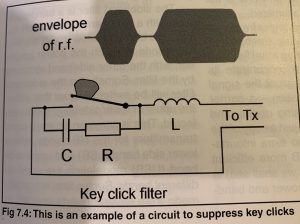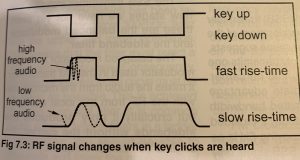THE MARCONI NATO KEY
The Marconi Nato Morse Key
…..or to give its proper nomenclature 5805-99-541-1439 Key Telegraph. This is a
serious morse key, clearly for use in a military or service environment.
Unlike most morse keys which basically have two terminals that you connect via a jack plug to
your transmitter KEY socket, this beast has a 6 way terminal block under the cover
and an internal wiring loom. But before we get into the detail, why did I purchase this
particular key? Well it was on my list of “always wanted” keys together with the
Vibroplex semi auto bug; the Eddystone Semi-auto Bug; the Marconi Marine 365
straight key and a Kent straight key. I have promised myself that, apart from the
Marconi 365, the list has been satisfied, and it will have no further additions. There
were also historical connections of a past life working for the Marconi Company,
where we made the communications systems equipment for the Navy that these
morse keys worked with.
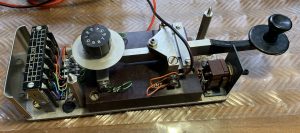
Nato key with cover removed
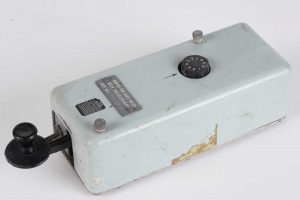
This key was designed for use by NATO forces by Marconi S & R Systems and
made by Pryce Edwards Ltd in the 1970-80s and has the serial number PES 022 85
which would indicate a manufacture date of 1985. The key weighs 3 ½ ls (1.6kg) and
the cover measures 8” x 3.25” (203mm x 83mm) with an overall length including key
of 10.5” (268mm). My key has an ABS cover, others with slightly different NATO
numbers had covers made of brass or steel painted battleship grey.
The key is based on the Swedish Twin Contact design key c1940 by Lennart
Petersson, which is also known as the Swedish pump key; It uses a spring plate for
the support and spring tension on the main rocker/sending lever arm. There is a
spring tension adjuster, using a spanner and an allen key, that can only be accessed
by removing the cover. The key has preset contact gap adjustments using a round
black knob on the top marked 0 -9. 0 being closed contacts; 9 being widest open.
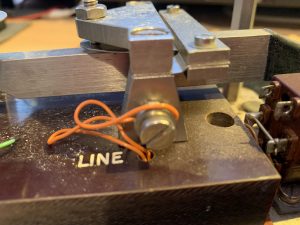
Swedish Pump Key Spring action
I bought this key at an auction in Newcastle, so had no opportunity to examine
before bidding on it. It was with a collection of 5 other morse keys. Some few months later I took it off the shelf and decided to have a close examination of it. The first thing I noticed was that it had a ON/OFF switch which is unusual in a morse key.
Second, there did not seem to be any cable entry point, although there was a blank panel at the rear of the cover. Two thumb screws hold down the cover which slides off the base, revealing the key, the terminal block, contact adjustment knob, and ON/OFF switch. This was clearly a complex piece of equipment. Behind the terminal block there was a removable aluminium panel which could be removed and have a hole drilled for a cable gland. This made me think that the key had never been usedin service or modified for amateur use.
The Terminal Block can be seen at the rear of the key and it has the following label
markings;
6- C
5- S
4- LINE
3- MK (MARK)
2- SP (SPACE)
1- E (EARTH)
As this is a “two contact” key, I assumed that key lever was LINE and the UP contact
when key is pressed is MARK. When the key is at rest (down) this connects the LINE
to the SPACE contact. Trying to prove this with a continuity meter proved
problematical for reasons I will explain later. I could clearly see stand-off insulators
interfaced between the terminal block and the base of the key. Further investigation
led me to unscrew the base from the bottom place. This turned out to be some
hollowed out plastic material containing a pair of Capacitor – Resistor Key click
filters. (See below for a comment on Key Clicks). Faced with this and the continuity
problem, I decided to trace out the wiring diagram for the key, but I still couldn’t be
sure how the key click filter was wired into the circuit. Fortunately FISTS member Bill
G0ELZ sent me a circuit he had which confirmed everything. The circuit is shown below.
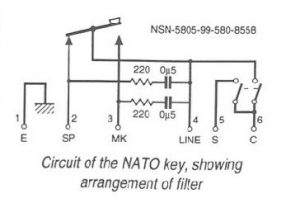
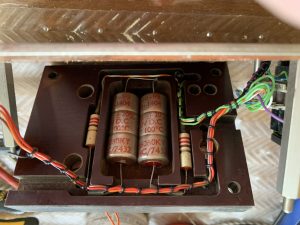
C & R Key click Filter in base
I made some enquiries on the FISTS forum and Facebook about the key and was
told that the ON/OFF switch on the front of the key, is for switching the key out of
circuit of any transmitter, thus giving the operator control, and can prevent
accidental keying of the transmitter by knocking the key. Given that these keys would
be controlling transmitters located somewhere else on the ship or establishment this
seemed a reasonable explanation. Dave M0VBY another FISTS member said that
the S and C on the terminal strip probably stood for Screen and Common.
Dave’s first encounter with the Marconi NATO key was late 1972/73 when he served on
HMS Bristol taking the new Integrated Communication System 2 (ICS2) to sea for
sea trials and later as a fully operational capability. (Dave was a maintainer, not an
operator).
Dave said he had no evidence that this key was used anywhere other than the RN
and that the Nato stock number plate has given rise to the assumption that it was
Nato use. All naval equipment had a Nato stock number, replacing the old Admiralty Pattern no. The two digit 99 was the indicator that it was manufactured in the UK. In ICS2 the key was fitted in a comms bay on a sliding tray and could not be removed. It was connected by a Switch Unit Radio to the KMM control system, (Thanks for that
information Dave)
The continuity problem I referred to earlier concerned the MARK contact. When I
pressed the key lever the LINE contact on the lever should make with the MARK
contact and complete the circuit resulting in the key tone. There was nothing.
Eventually I realised that there must be corrosion on the key contacts so I removed
the screws holding the lever arm to get access to the contact points on the lever and
the key base.
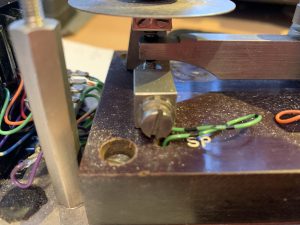
Up/Down contact
The contacts proved easy to clean up with a light file and when I re-assembled the
lever arm back on the key I was able to get a tone when the key was pressed. The
contact spacing knob is very stiff to turn so that could also do with a check out.
Seeing how it is put together, its looks to be a very fiddly job so I will leave that for
later.
I haven’t restored this key yet. It only needs a good clean to remove marks and dust.
I also haven’t modified the rear cable entry plate behind the terminal block, I will
defer a decision on this until later. What I have tried to do in this article is to find out
how the key works and how it was used in operation. I have learnt a few things which
is never a bad thing. Until the next one!
Chris G0EYO 31/1/25
Key Clicks – a perpetual problem
Nothing can be more annoying (and a quick way to ruin your reputation) to your
fellow operators, when, unknowingly, you generate key clicks on your signal. Clicks
are generated by any transmitter whose RF carrier amplitude rises or falls too
rapidly, (which essentially is what a square wave CW signal is). They are heard as
clicking in time with the CW but audible on many frequencies right across the band
and are nothing to do with the operator keying speed. They arise because of the
rise-time of the carrier when the key is depressed. A very fast rise-time can be
thought of as a small part of a high frequency audio signal and it produces very wide
side bands. Conversely, a slower rise time equates to a lower frequency audio
signal. Key clicks can be reduced by a simple CR timing filter in the keying stage
which will round off the edges of the CW square wave. See Figs 7.3; and 7.4 below 1
Note 1: copied from the RSGB Intermediate Training Manual 2nd edition
